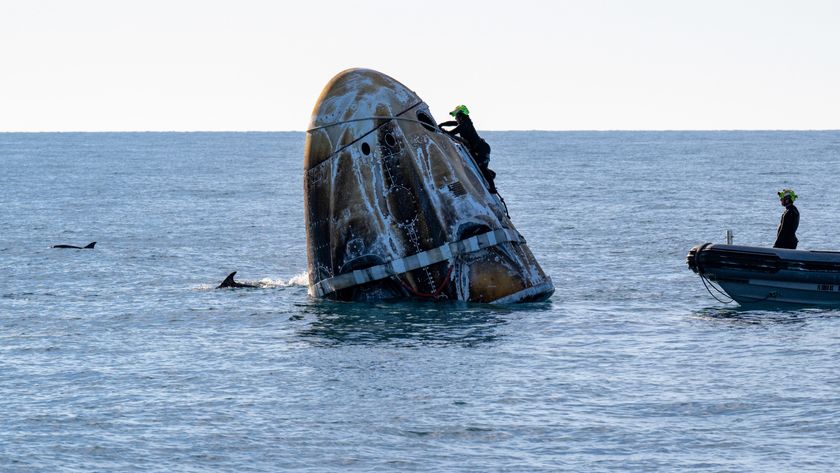
WASHINGTON — A draft authorization bill from the House Science space subcommittee would cap NASA spending at about $16.87 billion for the next two years, prohibit a proposed asteroid retrieval mission, overhaul the agency’s management structure and raise the spending cap for Commercial Crew activities while increasing congressional oversight of the program.
The bill, as Republican lawmakers have been hinting during House Science, Space and Technology Committee hearings all year, also aims to steer the nation’s human spaceflight program back to the moon and provide more money for robotic exploration of the solar system at the expense of NASA’s Earth observation program.
These and other changes were detailed in a copy of the bill, the NASA Authorization Act of 2013, obtained by SpaceNews on June 14. The bill holds NASA to spending levels established by the Budget Control Act of 2011, rather than assuming that Congress and the White House will eliminate sequestration’s across-the-board spending cuts any time soon. [NASA's Asteroid-Capture Mission in Pictures]
The House Science space subcommittee will discuss the bill in a hearing on Wednesday (June 19). The Senate Commerce Committee, meanwhile, is “not too far behind” its House counterpart in finishing its own version of the next NASA Authorization bill, Ann Zulkowsky, a senior aide in the Democrat-controlled Senate, said June 14 at the Aerospace 2013 conference in Arlington, Va., organized by Women in Aerospace.
Industry sources said the Senate version of the bill does not hold NASA to the sequestered spending limits. One of these sources said the Senate was expected to unveil its authorization bill, which sets policy and spending guidelines for five years rather than two, this week.
Moon versus asteroid
The House Science space subcommittee’s bill includes many prescriptions for NASA’s human spaceflight program and would codify that Mars, by way of the lunar surface, is a priority destination for human explorers.
Get the Space.com Newsletter
Breaking space news, the latest updates on rocket launches, skywatching events and more!
"It is the policy of the United States that the development of capabilities and technologies necessary for human missions to lunar orbit, the surface of the moon, the surface of Mars and beyond shall be the goals of the Administration’s human spaceflight program," the bill states.
An asteroid retrieval mission, proposed by NASA in April as part of the White House’s 2014 budget request, has no place in that framework, according to the draft bill.
"The Administrator shall not fund the development of an asteroid retrieval mission to send a robotic spacecraft to a near-Earth asteroid for rendezvous, retrieval and redirection of that asteroid to lunar orbit for exploration by astronauts," the bill states.
There has been a notable lack of enthusiasm for the asteroid mission among some of the Republicans who hold key NASA oversight roles in the House — including House Science Committee Chairman Rep. Lamar Smith (R-Texas) — since the mission was proposed.
The mission would require development of a robotic spacecraft with solar-electric propulsion, and the Orion Multi-Purpose Crew Vehicle and Space Launch System (SLS) heavy-lift rocket NASA is developing. [Space Launch System Rocket for Deep-Space Flights (Images)]
There is no funding authorized for a crewed planetary lander or deep-space astronaut habitat in the bill.
Another provision of the draft authorization bill that originated with House Republicans is an overhaul of NASA’s leadership structure. The proposed changes would give Congress greater influence over the selection of the NASA administrator, and give the administrator a six-year term. The NASA administrator is currently a political appointee who serves at the president’s pleasure.
House Republicans led by Rep. John Culberson (R-Texas) included these changes in their Space Leadership Preservation Act (H.R. 823), which was introduced in February and has lingered in committee ever since. That bill was itself a rehash of a similar proposal introduced back in September 2012.
Funding for private spaceships
Also on the human spaceflight front, the draft authorization act the House Science Committee has produced authorizes up to $700 million a year for the Commercial Crew Program, which under the 2010 NASA Authorization Act was cleared for up to $500 million in annual funding.
A signature Obama administration effort, the Commercial Crew Program seeks to get at least one privately developed crew transportation system ready to launch astronauts to the International Space Station by the end of 2017.
NASA in August split $1.1 billion among Boeing Space Exploration of Houston, Sierra Nevada Space Systems of Louisville, Colo., and Space Exploration Technologies Corp. (SpaceX) of Hawthorne, Calif., to mature competing designs. NASA expects a follow-on award next summer after another funding competition now scheduled to begin around July. [The Top 10 Private Spaceships]
The White House has consistently sought more funding for the Commercial Crew Program than Congress has been willing to give. In 2013, the administration asked for more than $800 million and wound up with $525 million. NASA Administrator Charles Bolden has said repeatedly that Congress must meet the request, or the 2017 flight date will slip.
The House Science Committee’s draft bill calls on NASA to make sure that does not happen. The bill would require the space agency to evaluate the Commercial Crew Program’s prospects for making the 2017 deadline under annual funding levels ranging from $500 million to $800 million. The bill also establishes strict reporting requirements for the Commercial Crew Program, requiring NASA to brief Congress on the effort every 90 days, beginning 180 days after the bill becomes law.
In a related provision, the bill places a $50 million cap — to be exceeded only with permission from Congress — on Space Act Agreements, an alternative procurement mechanism NASA uses routinely. The current round of the Commercial Crew Program is funded with $1.1 billion worth of Space Act Agreements. However, NASA has already said it does not plan to use Space Act Agreements for the program’s next development phase.
An administration official panned the House proposal, calling it a "non-starter." The official asked for anonymity to speak candidly. Particularly objectionable, this person said, was the proposal to cut Earth Science and kill the asteroid retrieval mission.
The House subcommittee’s bill would authorize about $1.2 billion for Earth Science in 2014 and 2015 — about 30 percent less than the division’s budget in 2013 and 2012. The main beneficiary from this rebalancing would be the Planetary Science Division, which runs NASA’s robotic solar system exploration program.
Conversely, the bill would authorize planetary science for $1.5 billion in funding in 2014 and 2015, the same level the division received for 2012. NASA has proposed reducing planetary science spending for 2013, funding it at about $1.2 billion even though Congress provided a larger appropriation in the The Full-Year Continuing Appropriations Act of 2013 (H.R. 933), which became law March 26.
Budget proposal rundown
Rounded to the nearest million, authorized spending levels for major NASA spending accounts in 2014 and 2015 under the House Science space subcommittee’s proposal are:
— Top Line: $16.865 billion, about even with NASA’s 2013 appropriation and roughly 5.1 percent less than what NASA got in 2012 in its last unsequestered spending bill.
— Exploration Systems: $4.007 billion, 8.9 percent more than what NASA has proposed spending in 2013 under an operating plan it delivered to Congress in May, and 8.1 percent more than in 2012.
— Space Operations: $3.818 billion, 2.5 percent more than the NASA-adjusted level for 2013 and 8.8 percent less than in 2012.
— Science Mission Directorate: $4.627 billion, 3.2 percent more than in 2013 and 8.8 percent less than in 2012.
— Cross-Agency Support: $2.6 billion, 4.1 percent less than 2013 and 13.2 percent lower than in 2012.
— Aeronautics Research Mission Directorate: $566 million, 6.8 percent more than in 2013 and 0.6 percent less than 2012.
— Space Technology Mission Directorate: $500 million, 21.9 percent lower than in 2013 and 12.9 percent lower than in 2012. The bill would transfer some of the human spaceflight research and development funding now managed by this directorate back to the Exploration Systems account.
— Education Mission Directorate: $125 million, 7.8 percent more than in 2013 and 8.2 percent less than in 2012.
— Construction and Environmental Compliance and Restoration: $587 million, 9.3 percent less than 2013 appropriation and 18.7 percent more than in 2012.
— Inspector General: $35 million, about flat compared with 2013 and 8.6 percent lower than 2012.
Proposed authorized funding for SLS and Orion in 2014 and 2015 under the House subcommittee’s bill are:
— SLS: $1.772 billion, of which $1.454 billion would be for rocket development and support work, and $318 million would be for SLS ground systems. That puts vehicle development and support about 6.1 percent higher than in the 2013 operating plan and 2.9 percent lower than in 2012. Ground systems, meanwhile, would be authorized for 15.2 percent less than in 2013 and 4.4 percent more than in 2012.
— Orion Multi-Purpose Crew Vehicle: $1.2 billion, 7.7 percent more than in 2013 and even with 2012.
— The James Webb Space Telescope, meanwhile, would be authorized for $658 million in funding in 2014 and 2015, which are peak development years for the long-delayed, overbudget astrophysics flagship. The proposed authorized level is 4.9 percent more than 2013 and 26.9 percent more than in 2012.
This story was provided by Space News, dedicated to covering all aspects of the space industry. Article on SPACE.com.
Join our Space Forums to keep talking space on the latest missions, night sky and more! And if you have a news tip, correction or comment, let us know at: community@space.com.
Dan Leone is an editor and reporter for the ExchangeMonitor Publications covering the Department of Energy and Department of Defense nuclear weapons programs. From 2011 to 2016, Dan was the NASA reporter for the space industry publication SpaceNews, where he covered U.S. space agency policy, news and missions. He also produced the SpaceGeeks podcast showcasing interviews with space industry professionals. Dan earned a bachelor's degree in public communications from American University. You can find his latest project on Twitter at @leone_exm.













